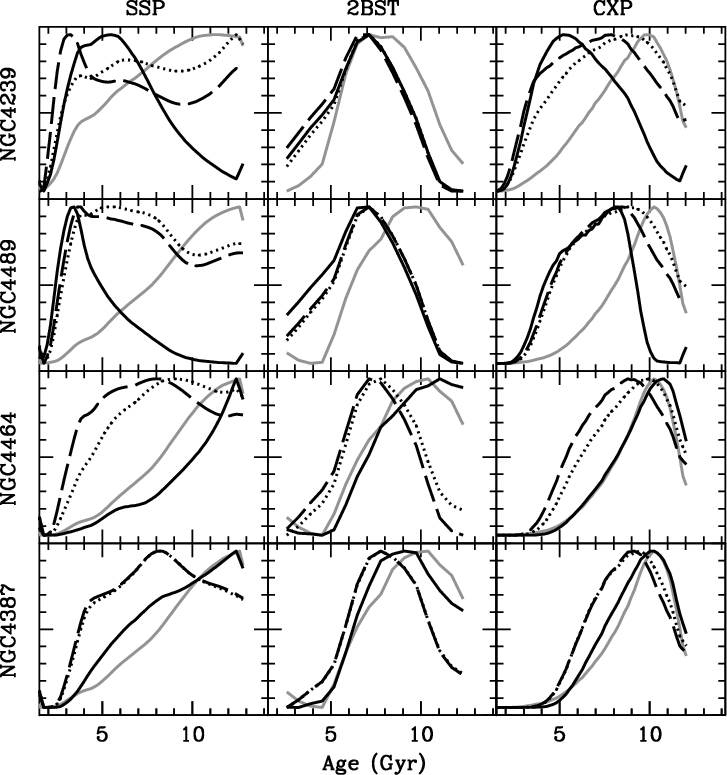
A good example of how the quality of the available models and data influence the use of tracers and the precision with which physical properties can be recovered is given by recent developments in the use of index fitting. Historically, early-type galaxies have been analyzed using simple stellar populations models as templates, effectively using the prior assumption that early-type galaxies were created in one single burst of star formation. However, detailed spectroscopic studies (Trager et al. 2000) as well as near-ultraviolet photometry of early-type galaxies (Ferreras and Silk 2000; Yi et al. 2005; Kaviraj et al. 2007) have confirmed the presence of hot stars in early-type galaxies.
Figure 15 illustrates that it is now possible and necessary to go beyond SSPs for early-types (see also e.g. Serra and Trager 2007). The marginalized age distribution is shown for four galaxies corresponding to three different models (from left to right): Simple Stellar Populations (SSP), a 2-burst model consisting of a superposition of an old and a young SSP (2BST), and a composite model assuming an exponentially decaying star formation rate, including a simple prescription for chemical enrichment (CXP). All these models combine the population synthesis models of Bruzual and Charlot (2003). The figure shows that SSPs give mutually inconsistent age distributions, whereas composite models such as 2BST or CXP give a more consistent picture. Notice how lower mass galaxies such as NGC 4489 or NGC 4239 (top panels) give better fits for a 2 burst scenario, whereas higher mass galaxies (NGC 4464, NGC 4387; bottom panels) are better fit by a smooth star formation history.

A similar analysis is presented in Trager and Somerville (2009), who analyze mock data from semi-analytic models in standard ways, in particular computing the “SSP-equivalent” ages and metallicities. They quantify that the SSP-equivalent age is poorly correlated with the mass-weighted or light-weighted average ages. The SSP-ages tend to be younger, biased to the star formation in the last 0.1-2 Gyr. This has in particular the effect of exaggerating the signature of downsizing. On the other hand, the SSP-equivalent metallicity is mostly equivalent to the light-weighted metallicity. This serves as an important reminder, that the prior assumption that one puts into the analysis are very important for the resulting measurement. In the case of using SSP-equivalent ages, the assumption, or prior, is that galaxies are single-age entities. This inevitably leads to important biases in the determined parameters.
Among the important caveats of SED fitting, the issue of the age-metallicity degeneracy cannot remain unmentioned. This degeneracy is particularly important in the optical. In a nutshell, age effects on colors or line strengths can be mimicked by a change in metallicity. This is especially important in the old populations found in early-type galaxies. Equally important and generally well-understood are the effects of using the optical SED only to determine the attenuation. Basically this is a very difficult undertaking and under almost any circumstance, measurements of the Balmer decrement, the FIR emission or the UV slope are essential to a reliable determination of the attenuation.
In principle it should be possible and informative to combine information from the photometric SED and spectral information (Gallazzi and Bell 2009; Lamareille 2009). While widespread use of this combination is hampered by possible systematic differences in the results (e.g. Wolf et al. 2007; Schombert and Rakos 2009), general agreement between both types of information has been claimed at least for stellar masses (Drory, Bender, and Hopp 2004). Brinchmann et al. (Talk at workshop) showed the results of a systematic comparison between photometric and spectral SED fitting. Comparing formal errors, they find no significant systematic offset. However, for actively star forming galaxies it might be better to use multiwavelength, broad-band photometry than the detailed spectrum information. The reason is, as mentioned in Section 4.4.3, that very young stars tend to “hide” in the normalized optical part of the spectrum, however they are readily visible as blue continuum in the multi-wavelength SED. On the other hand, spectra are better at picking up recent bursts through their Balmer lines (e.g. Wild et al. 2007, 2009). Emission lines are a potential problem for fitting photometric SEDs. A quick back of the envelope calculation, however, shows that they produce a maximal offset in r-i colour of 0.1 at an equivalent width of 100 Å. Thus, ELs are a minor issue in the broad-band colours when a full SED is available and of limited concern for normal z~0 galaxies4.
Galaxies with significant redshifts can in principle be treated the same way as local ones, subject to two main caveats though: (1) we currently do not have the same kind of information available for large samples of galaxies at redshifts above 1 as for local galaxies. (2) Galaxies at high redshifts may have been significantly different from todays galaxies, e.g. concerning their typical star formation histories, their metallicities or their gas content. As local analogs are rare or lacking, SED models are less well calibrated and may be subject to considerable systematic uncertainties. These need to be explored in detail, which is currently only possible through semi-analytic models (see e.g. Schurer et al. 2009). The design limits of SED fitting codes should thus be kept in mind when quoting results and – in particular – errorbars on high redshift properties.